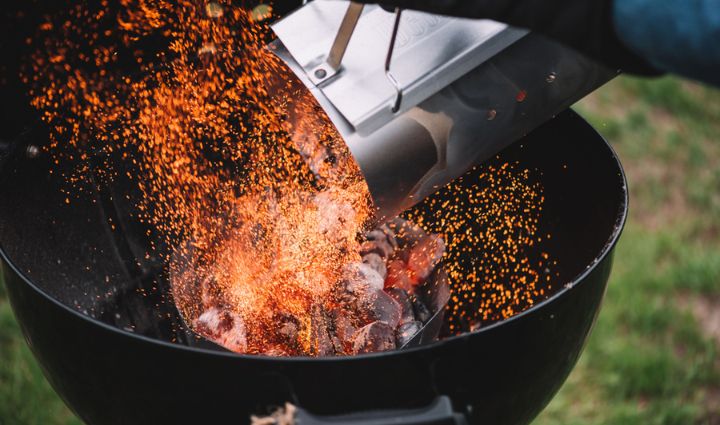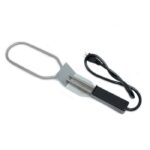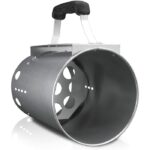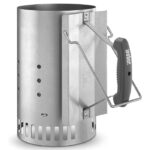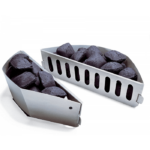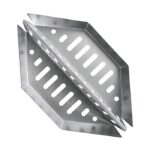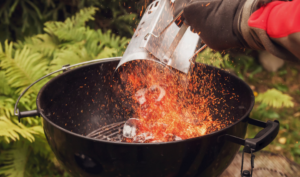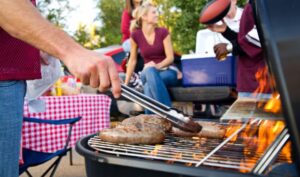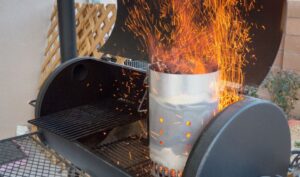Setting up a gas grill is pretty straightforward—simply fire up the burners you need, wait a few minutes for your barbecue to reach the right temp, and you’re good to go. Charcoal grills, on the other hand, take a bit more prep and planning.
From choosing the right charcoal to arranging the coals for optimal heat distribution, there’s more to setting up a charcoal grill than hitting an igniter button. The process can seem a bit intimidating if you’ve never used a charcoal grill before, but the basics are actually quite simple.
Whether you’re new to grilling entirely or just new to charcoal grilling, in this post we will teach you how to set up a charcoal grill from start to finish, including:
- Types of charcoal
- What type of charcoal to use
- How much charcoal to use
- How to light a charcoal grill with and without a chimney starter
- Setting up direct and indirect heating zones
Let’s get cooking.
1. Types of Charcoal
The first thing you’ll need when you’re learning how to use a charcoal grill is, well, charcoal. There are many different types of charcoal, but not every type of charcoal is right for every grill or meal. When you understand the basic differences between types of charcoal, you can confidently choose the right one for your cookout. (Don’t worry, we will also share our advice in the next section of this post).
In this post, we will focus on the types of charcoal you are most likely to encounter and use:
- Lump charcoal
- Charcoal briquettes
- Hardwood briquettes
Lump charcoal
What it’s made of: A variety of hardwoods and fruitwoods
Cost: $-$$$
Shape: Irregular lump shapes
Pros
- Responds well to oxygen so you can use the vents on your charcoal grill to adjust temperature quickly
Cons
- Irregular shapes can make the chimney-lighting process slightly more challenging
- Larger lumps of charcoal may contain impurities that can result in sparking and excessive smoke.
Charcoal briquettes
What it’s made of: A mix of compressed hardwood and softwood charcoal and other types of wood scraps and sawdust mixed with a binder (such as cornstarch or petroleum) and other brand-dependent additives like limestone or borax
Cost: $
Shape: Uniform size and shape
Pros
- Inexpensive
- Easy to find
- Reliable
- Slow burning
Cons
- Can produce an unpleasant odor when lit because they aren’t 100% wood
- There can be health risks associated with inhaling the smoke. This can sometimes be avoided by checking the package to confirm what it contains.
Hardwood briquettes
What is it made of: Primarily hardwood charcoal mixed with binders such as starch, clay, or other plant-based adhesives.
Cost: $$
Shape: Slightly more regular than charcoal lumps
Pros
- Burn hotter than charcoal briquettes
- Don’t contain fillers or binding agents
- Can impart some of the wood smoke flavor if you select a specific type of hardwood (mesquite or applewood, for example
Cons
- Burn for a shorter time, and somewhat less evenly
- Slightly more expensive than charcoal briquettes
Not sure what type of charcoal is best for your cookout? Learn more about these and other types of BBQ charcoal and when to use them.
2. What Type of Charcoal to Use
The type of charcoal you select will impact how easy it is to light your grill, how hot the grill will get, and how long it will stay hot. It can also impact flavor.
If you’re spending good money on meat to grill, it makes sense to use the best charcoal you can afford. If you can find all-natural charcoal, all the better. Premium products offer easier lighting, consistent heat, and better flavor without chemicals.
3. Lighting a Charcoal Grill
You can light a charcoal grill with or without a chimney or electric starter. A starter isn’t necessary, but it can make the process a bit easier without requiring fire-starting chemicals.
Using a chimney starter
- Fill the chimney with enough charcoal to get it to the temperature you need.
- Place the fire starter (such as newspaper or lighter cubes) under the charcoal chimney on the charcoal grate, on the lower of the grill’s two grates. This positioning gives you enough room to light the fuel source and place the chimney on top of it.
- Light the fire starter with a BBQ lighter.
- Place the chimney over the flame. For optimal airflow, leave the grill’s lid open and allow the flames to rise through the chimney. Hot air will rise along with the flames, and the fresh air that’s pulled through the bottom of the chimney will ignite the coals quickly.
- After about 15 minutes, once the top of the hot coals have turned a bit gray with ash, slowly and carefully dump the hot coals onto the charcoal grate.
- Use a charcoal rake or grill tongs to distribute the charcoal for direct or indirect grilling.
- Close the lid for five to ten minutes to allow the grill to get up to temperature
Using an electric starter
- Arrange the charcoal into a neat pyramid shaped mound.
- Place the starter into the coals and switch it on.
- Once the coals begin to light, pull the starter out from the coals slightly and leave it until all the coals are lit.
- Remove the starter and turn it off.
- Spread out the coals using a charcoal rake while wearing safety gloves. Cover the coals with the grate and lid and let the grill preheat for 5 to 10 minutes.
Shop for electric charcoal starters:
Without a chimney starter
Typically, lighting a charcoal grill without a chimney starter involves starting your charcoal grill with a petroleum- or alcohol-based lighter fluid.
SAFETY TIP: When using lighter fluid to start your grill, following safety precautions and knowing how much lighter fluid to use are the keys to success. Using too much lighter fluid can be dangerous, and excess lighter fluid can also transfer a chemical taste to your food. Never squirt lighter fluid onto hot or flaming coals.
- Just like with the electric starter, arrange the charcoal into a neat pyramid shaped mound.
- Add lighter fluid to the pile of unlit charcoal. At most, you should use ¼ cup of fluid per pound of charcoal. Always follow the directions on the bottle of lighter fluid you use.
- Allow the lighter fluid to soak into the coals for a maximum of 30 seconds before introducing flame to the grill. The fuel can evaporate if the coals are left too long without being ignited, making the coals more difficult to light. Have your fire source ready to go so you can set the coals on fire as soon as you douse them.
- Use your grill lighter or a long match to light the coals in several places, helping the fire get started and spread over every coal. Do not add more lighter fluid after setting fire to the coals.
- Give the lighter fluid time—about 15 minutes—to burn off and turn the coals gray. Don’t start cooking until ash covers all of the briquettes and they stop smoking.
- Using a charcoal rake, spread out the grey ash-covered coals. Cover the coals with your grate and lid to let the grill preheat for 5 to 10 minutes.
4. How Much Charcoal to Use
Because you regulate a charcoal grill’s temperature by adjusting the amount of charcoal you use, how much charcoal you need will depend on the size of your grill and what you are cooking. Small, portable grills use roughly 25-35 briquettes, and larger grills use between 50-75 briquettes, depending on what you are cooking and how hot you need your grill to get.
Shop for chimney starters:
5. Setting Up Direct and Indirect Heat Zones
Once your coals are lit, it’s time to arrange them on your grill. This usually means creating two zones—one for direct heat and another for indirect heat cooking.
Setting up direct and indirect heating zones on a charcoal grill is as simple as placing the charcoal in strategic locations on the grate or positioning them inside of charcoal baskets on the grate.
Direct heat grilling
Direct heat grilling means grilling directly over top of the lit charcoal. To set up a direct heat grilling situation, pour the lit coals in an even layer, spread them out over the bottom grate, and place the top grate over the coals.
Best for: Fast cooking items, such as thin cuts of meat, burgers, hot dogs, skewers, veggies. Also good for cookouts and parties because it gives you the largest amount of space to grill with.
Indirect heat grilling
Some items are best cooked over indirect heat. There are a few different ways to set up a charcoal grill for indirect heat grilling. Here are two of the most commonly used methods:
Two-zone indirect grilling
Two-zone – A two-zone setup means creating a hot zone on one side of the barbecue and a “cool” zone on the other. To do this, all you have to do is pour an even layer of charcoal on half of your bottom grate and leave the other side empty.
Best for: Items that require you to start in a cool zone and switch to a hot zone or vice versa, such as whole chickens, ribs, pork chops, and other thick cuts of meat.
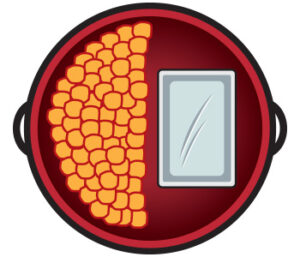
Three-zone indirect grilling
A three-zone setup involves two hot zones and one cool zone. Using charcoal baskets is a great way to set up this arrangement. All you have to do is load charcoal in the baskets and then place them on opposite sides of the grate, positioning the baskets so the items you are grilling will not be directly over the hot coals. If you don’t have baskets, you can simply pour the briquettes directly on the lower grill grate.
Best for: Food that needs less heat and more time to cook, such as small chickens, Cornish game hens, pork tenderloin, and other smallish cuts that require indirect heat. You can even bake brownies and bread on a grill using indirect heat.
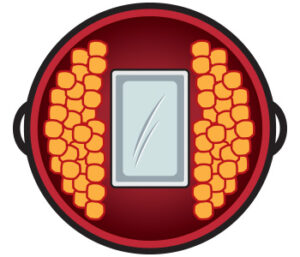
Shop for grill charcoal baskets:
Wrapping Up
Setting up a charcoal grill might seem challenging, but it’s actually a simple process:
- Prepare your coals by loading them in the chimney or arranging them into a pyramid shape
- Light your coals And let them turn an ashy white
- Dump them onto the grill into either a direct or indirect heat grilling arrangement, depending on what you are cooking
- Shut the lid and let the grill preheat for 5-15 minutes
- Start grilling!

